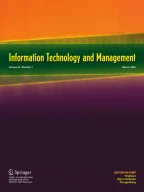Abstract
Business processes can be modeled using a variety of schemes such as Petri Nets, Metagraphs and UML Activity Diagrams. When information analysis is as important an objective as the proper sequencing of tasks, the metagraph formalism is the most appropriate. In practice, however, metagraphs have not achieved wide popularity. Here we propose a modification of the original formulation that eliminates some of the inconveniences that have hindered the use of this technique. We represent a business process as a Task-Precedence Metagraph (TPMG), which is a type of AND/OR graph. A TPMG is similar to a metagraph but is visually clearer and more appealing, and the algorithmic procedures are graphical rather than algebraic. We first describe the proposed representation scheme for TPMGs and present a simple graph-search algorithm for the analysis of information flow. This can be readily extended to perform task analysis, resource analysis, and operational (i.e., semantic) verification. We then present a generalized graphical algorithm for structural (i.e., syntactic) verification that runs correctly not only on TPMGs containing directed cycles, but even on those that have overlapping patterns.
Similar content being viewed by others
References
W. van der Aalst, and K.van Hee, Workflow Management: Models, Methods and Systems (The MIT Press, 2002).
A. Basu, R.W. Blanning, A formal approach to workflow analysis. Information Systems Research 11(1) (2000) 17–36.
A. Basu, R.W. Blanning, Metagraphs in workflow support systems. Decision Support Systems 25(3) (1999) 199–208.
A. Basu, R.W. Blanning, Metagraphs: a tool for modeling decision support systems. Management Science 40(12) (1994) 1579–1600.
C. Bettini, X. Wang, S. Jajodia, Temporal reasoning in workflow systems. Distributed and Parallel Databases 11(3) (2002) 269–306.
H.H. Bi, J.L. Zhao, Applying propositional logic to workflow verification. Journal of Information Technology and Management, Special Issue on Workflows and E-Business (2004)
G. Booch, J. Rumbaugh, I. Jacobson, The Unified Modeling Language User Guide (Addison Wesley, 1999)
B. Curtis, M.I. Kellner, J. Over, Process modeling. Comm ACM 35(9) (1992) 75–90.
E. Deborin, J. Basral, Continuous Business Process Management with HOLOSOFX BPM Suite and IBM MQSeries Workflow (IBM Corporation 2002)
R. Liu, A. Kumar, An analysis and taxonomy of unstructured workflows, BPM 2005, Lecture Notes in Computer Science, Vol. 3649 (Springer Verlag, 2005)
A. Mukherjee, A.K. Sen, A. Bagchi, Information analysis in workflows represented as task- precedence metagraphs. Proc WITS-2004 (Workshop on Info Tech and Systems, Seattle 32–37, 2004)
A. Mukherjee, Selected Issues on Workflow Representation, Analysis and Verification, Fellow Programme Thesis, Indian Institute of Management Calcutta (2005)
N.J. Nilsson, Principles of Artificial Intelligence (Tioga Press, 1980)
J. Pearl, Heuristics: Intelligent Search Strategies for Computer Problem Solving, Addison Wesley (1984)
W. Sadiq, M.E. Orlowska, Analyzing process models using graph reduction techniques. Information Systems 25(2) (2000) 117–134.
P. Sinnakkrishnan, A. Mahanti, A simple and efficient technique for verifying workflow graphs, in: WfMC Workflow Handbook, L. Fischer (ed.) (Future Strategies, 2005), pp. 233–256
WfMC, Terminology and Glossary, Technical Report, TC-1011 (Workflow Management Coalition, Hampshire, UK, 1999)
J. Wang, A. Kumar, A framework for document-driven workflow systems, BPM 2005, Lecture Notes in Computer Science, Vol. 3649 (Springer Verlag, 2005).
Author information
Authors and Affiliations
Corresponding author
Additional information
Editor-in-Chief’s Note: An earlier version of this paper was accepted for WITS2004. The authors were subsequently invited to submit an expanded paper for publication consideration in Information Technology and Management. The conference co-chairs, Professors Amit Dutta and Paulo Goes were the guest editors for this paper.
Appendix
Appendix
Rights and permissions
About this article
Cite this article
Mukherjee, A., Sen, A.K. & Bagchi, A. The representation, analysis and verification of business processes: a metagraph-based approach. Inf Technol Manage 8, 65–81 (2007). https://doi.org/10.1007/s10799-006-0004-4
Published:
Issue Date:
DOI: https://doi.org/10.1007/s10799-006-0004-4
